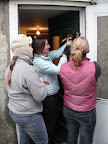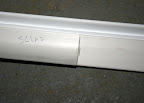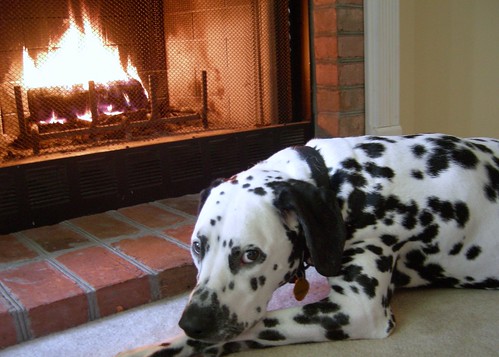
UPDATE 12/28/2010: Nails used to install Q-Lon should be either galvanized or stainless steel to prevent rusting.
UPDATE 2/27.2011: I’ve updated step #11 – the Q-lon kit comes with three pieces: a top, a left and a right. The left and right are NOT interchangeable. Make certain you measure and cut the correct one.
Q-Lon is one of the few materials we use that you can’t get in most hardware stores. Typically stores will carry a few different types of door weatherstripping that run from mediocre to really bad. They’re flimsy, don’t seal out the air, can be difficult to install and you’ll be lucky if they don’t fall apart within three years.
By contrast, Q-Lon costs about the same amount but will do the job well and last many years.
Installation isn’t difficult, but I still see professionals install it wrong all the time. All it takes is a few simple tips and tricks, and about 45 minutes, to install properly so it does the job right, you can still close your door, and it lasts a very long time. Purchasing information is at the very bottom.
HOW TO INSTALL Q-LON PROPERLY
1. Measure the top of the door, side to side, then measure it again.
2. Cut the top piece of Q Lon (the smallest of the three pieces) to size. Remember that it is better to cut too large than too small because you can always cut it smaller but not make it longer. A hack saw or a back saw works well. NOTE: I always cut the rigid vinyl piece to size but try to leave a small amount (1/2” or less) of the foam gasket extending from either side. This buys you some margin of error when cutting the Q Lon.
3. Close the door and lock/latch it. (This is where installation usually fails: Most installers don’t latch the door, and the result is a poor/loose fit.) Push the Q Lon into place, compressing the foam gasket against the door 30-40%. (Remember that you want a tight seal but you do NOT want the door to be impossible to close.)
4. With the Q Lon in place use a pencil to scribe the back edge (the one without the foam) so you know exactly where the piece should sit. Note that the line is visible and a small distance back from the QLon.
5. Lay a bead of caulk on the flat side of the Q Lon (the part that will rest on the top jamb of the door) and put it into place.
6. IMPORTANT: When you scribed that pencil line you could see it, right? You want to make sure that when you put the Q Lon in place that you can still see it.
7. Open the door. This is another place installers frequently fail and the reason we scribed the line. Holding and nailing Q Lon into place with a closed door ½” away is a recipe for disaster, usually involving whacking the door with the hammer.
8. Holding the Q Lon in place you should nail it in (using galvanized or stainless steel 4D nails), starting about 2″ from one side and every 6″ to 8″, with another approximately 2″ from the opposite side. After each nail check placement along the scribed line – nailing in place tends to shift the QLon.
9. Close the door again to make sure it seals well. A good seal means that you can’t slip a piece of paper between the door and the gasket, but that the door can still close easily. Rejoice.
10. Measure a side of the door jamb (NOTE: Frequently the sides will differ in size.) I like to measure from the installed rigid piece, just inside the foam, to the floor. Measure it again.
11. Take one of the longer pieces of Q Lon and find the side with the correct “cope” NOTE: Each long piece is designed for a specific side, either right or left, of the door. They are NOT identical. Each has a cope (a curved piece has already been cut out.) That “cope” will, when installed, fit perfectly around the piece you’ve installed at the top of the door. When in doubt about which is for which side, hold it up to the top piece – it will quickly become evident.
12. Measure from the bottom of the cope (see picture at right), not the tip, to the threshold to

- Measure from the bottom of the cope, closest to the foam gasket.
determine the length you need. Measure and mark the piece.
13. You can now use the scrap from the top to mark a perfect 90 degree line – using the machined edge of the scrap, lay it on the piece to be cut, flat side to flat side, at the mark you made (see right). This lines up perfectly to give you a perfect mark to cut on.

- Use machined edge of scrap to get perfect 90 angle
14. Cut. NOTE: I always cut the vinyl piece to size but try to leave a small amount (1/2″ or less) of the foam gasket extending from either side. This buys you some margin of error when cutting the Q Lon.
15. Slip it in place to make sure it is the correct size. Adjust if necessary. Once it is correct you should close the door, latch/lock, and scribe.
16. Pull it away from the door again and follow the same instructions as for the top piece: caulk and nail, keeping the scribe line visible. Be careful not to nail too close to the top coped portion as it is weaker and may crack. Allow at least 2″ below the cope for the first nail.
17. Again, close and latch/lock the door to make sure the fit is correct.
18. Measure the opposite side and follow instructions 10 thru 17.
IF THE DOOR DOES NOT CLOSE PROPERLY or for any other reason you need to remove the Q Lon to reinstall:
This is a difficult thing to do without snapping the Q Lon. It is vinyl and sturdy once in place but does not like to be pried out. Using at least two pry bars or at least two flat-head screwdrivers, start at one end and gently pry the Q Lon up, away from the door. Pry it out only a little bit and move along the length of the piece and do not, for example, try to pull the bottom end off of the door while leaving the middle/top attached. You need to pry a little bit at a time going up and down the length of the piece. If you don’t do this you will almost certainly snap the piece.
IF YOU CUT A PIECE SLIGHTLY TOO SMALL there are a few workarounds:
-
EASIEST. If you cut the side a bit too small you may be able to place a bit of backer rod in the location, caulking/tack nailing it into place.
-
LESS EASY: If your gap can’t be fixed with backer rod you should cut a piece of scrap Q Lon approximately 4″ long. Place that piece on the door threshold (the piece under the door that you step on) against the installed Q Lon. Using the top of the scrap Q Lon as a guide, scribe the installed Q Lon. Cut the installed Q Lon at the point of the scribe and remove it. Caulk and nail the scrap piece in that location.
HOW TO PURCHASE Q-LON:
If you’d like to purchase some Q-Lon please contact:
Steve Lavelle: wholesale@efi.org and 800-876-0660 ext. 1 and tell him A-HEET sent you!


